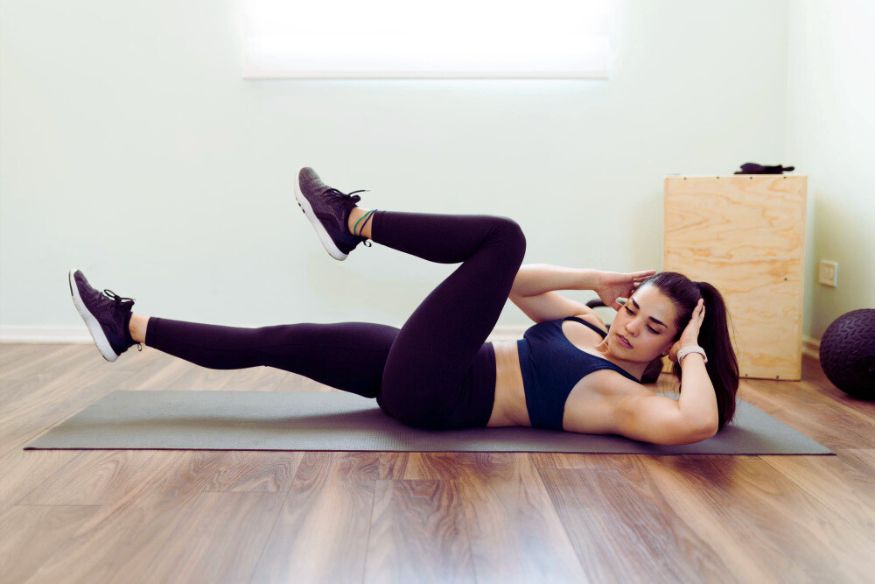Pilates is a popular form of exercise that emphasizes strength, flexibility, and overall physical fitness. This low-impact workout is great for those looking to improve their core strength and posture. However, incorporating a trampoline can be a great option for those looking to maximize their Pilates routine and add an extra level of challenge and benefit.
Trampolining has been shown to provide numerous benefits, including improved cardiovascular health, increased muscle strength and coordination, and even a boost to the lymphatic system. By combining Pilates exercises with trampolining, individuals can achieve a full-body workout that targets all major muscle groups while also improving balance, coordination, and overall fitness.
In this article, we will explore how to incorporate a trampoline into your Pilates routine to get the most out of your workout and achieve optimal physical fitness. Whether you are a beginner or an advanced Pilates practitioner, trampolining can be a fun and effective way to take your workout to the next level.
Benefits of Incorporating Trampoline into Pilates Routine
First and foremost, using a trampoline during Pilates adds an element of cardio that is typically not found in traditional Pilates exercises. The trampoline allows for a low-impact cardio workout that keeps your heart rate up and burns calories. This is particularly beneficial for those who are looking to lose weight or improve their cardiovascular health.
In addition to the cardio benefits, using a trampoline also uniquely engages your core muscles. The unstable surface of the trampoline requires you to engage your core muscles to maintain your balance and stability. This means that every movement on the trampoline works your muscles and improves your balance and coordination.
Another benefit of using a trampoline during Pilates is that it allows for more range of motion in specific exercises. For example, when performing exercises like the Teaser or the Roll-Up on the trampoline, you have more space to roll back and extend your legs without hitting the ground. This can help you to deepen the stretch and engage your muscles more effectively.
How to Choose the Right Trampoline for Pilates?
When it comes to choosing a trampoline for Pilates, there are a few things to consider. First and foremost, you want to ensure the trampoline is the right size for your needs. If you are planning on using it primarily for Pilates, then a smaller trampoline (around 36 inches) should suffice. However, if you want to use it for other purposes, such as rebounding workouts, you may want to consider a more giant trampoline.
You also want to ensure the trampoline has a sturdy frame and good-quality springs. Cheaper trampolines may have weaker springs that can wear out quickly or even break, which can be dangerous. Look for trampolines with heavy-duty springs and a frame that can support your weight.
Ans always consider the trampoline’s safety features. Look for trampolines with a safety enclosure net that can help prevent falls or accidents. You may also want to consider trampolines with padded edges to prevent injuries from hitting the frame.
Safety Measures to Consider While Using a Trampoline for Pilates
While using a trampoline during Pilates can be a fun and effective way to work out, it is critical to take safety measures seriously. Before beginning any trampoline workout, ensure you have a clear and open space to work in. Remove any obstacles or potential hazards from the area, such as furniture or sharp objects.
It is also vital to wear appropriate footwear when using a trampoline. Athletic shoes with good grip and support can help prevent slips or falls. Avoid using the trampoline barefoot or in socks, as this can increase the risk of injury.
Finally, be sure to follow proper form and technique when using the trampoline. Keep your knees slightly bent and your core engaged to maintain your balance and stability. Avoid jumping too high or performing any movements that feel uncomfortable or unsafe.
Warm-up Exercises Before Beginning Pilates Trampoline Workout
Before beginning any workout, including a Pilates trampoline routine, it is essential to warm up your muscles to prevent injury properly. Here are a few warm-up exercises that you can do before beginning your Pilates trampoline routine:
Jumping jacks: Start by doing a set of jumping jacks to get your heart rate up and warm up your muscles.

Squats: Perform a few squats to warm up your leg muscles and improve your range of motion.
Arm circles: Stand with your arms outstretched and make small circles with your arms, gradually increasing the size of the circles.
Cat-cow stretch: Get down on your hands and knees and alternate between arching your back (cow) and rounding your back (cat). This will help to warm up your back muscles.
Step-by-Step Guide to Pilates Trampoline Routine
Now that you are warmed up and ready to go, let’s dive into a step-by-step guide to a Pilates trampoline routine.
- Warm-up: Begin by performing the warm-up exercises listed above for 5-10 minutes.
- Jumping jacks: Perform a set of jumping jacks on the trampoline to increase your heart rate.
- Teaser: Lie on your back with your arms extended over your head and your legs extended straight. Slowly roll up, reach your arms towards your toes, and then roll back down. Repeat for 10 reps.
- Jumping jacks: Perform another set of jumping jacks on the trampoline.
- Roll-Up: Lie on your back with your arms extended over your head and your legs extended straight. Roll up, reach your arms towards your toes, and then roll back down. Repeat for 10 reps.
- Jumping jacks: Perform another set of jumping jacks on the trampoline.
- Plank: Place your hands on the trampoline and extend your legs straight behind you into a plank position. Hold for 30 seconds.
- Jumping jacks: Perform another set of jumping jacks on the trampoline.
- Mountain Climbers: Place your hands on the trampoline and bring one knee towards your chest, then alternate legs as if running in place. Do this for 30 seconds.
- Jumping jacks: Perform a final set of jumping jacks on the trampoline.
- Cool-down: Finish your workout with a few minutes of light bouncing on the trampoline to bring your heart rate back down, followed by some stretches to cool down your muscles.

Variations to Pilates Trampoline Routine for Advanced Users
If you are an advanced user looking to take your Pilates trampoline routine to the next level, here are a few variations to try:
Double Leg Lifts:
Lie on your back with your legs straight up in the air. Slowly lower your legs down towards the trampoline, then lift them back up. Repeat for 10 reps.
Bicycle Crunches:
Sit on the trampoline with your legs extended out in front of you. Lean back slightly and bring one knee towards your chest, then alternate legs as if pedaling a bicycle. Do this for 30 seconds.

Single Leg Jumps:
Stand on one leg on the trampoline and jump, keeping your balance on one leg. Switch legs and repeat for 10 reps.
Tips for Getting the Most out of Your Pilates Trampoline Workout
To get the most out of your Pilates trampoline workout, here are a few tips to keep in mind:
Start slow:
If you are new to using a trampoline during Pilates, start with a few basic exercises and gradually increase the difficulty.
Focus on form:
Proper form and technique are crucial when using a trampoline. Focus on engaging your core muscles and maintaining your balance and stability.
Mix it up:
Feel free to mix up your Pilates trampoline routine with different exercises and variations to keep it challenging and exciting.
Stay hydrated:
Jumping on a trampoline can be a sweaty workout, so be sure to stay hydrated by drinking plenty of water before, during, and after your workout.
Pilates On Trampoline
Conclusion
Incorporating a trampoline into your Pilates routine can be a fun and effective way to maximize your workout and achieve optimal physical fitness. By combining the low-impact exercises of Pilates with the added benefits of trampolining, individuals can improve their cardiovascular health, increase muscle strength and coordination, and even boost their lymphatic system.
Keep in mind that start slowly and gradually build up the intensity and duration of the workout to avoid injury. With proper technique and safety precautions, trampolining can be a great addition to any Pilates routine. Whether you are a beginner or an advanced Pilates practitioner, trampolining can help you achieve a full-body workout that targets all major muscle groups while improving balance, coordination, and overall fitness.
So, if you’re looking for a new way to challenge yourself and take your Pilates routine to the next level, consider incorporating a trampoline and enjoy the benefits of this fun and effective workout.
Frequently Asked Question
Can trampolining help enhance my Pilates workout?
Yes, incorporating a trampoline into your Pilates routine can help enhance your workout by adding an extra level of challenge and benefit.
Is it necessary to have experience with Pilates before adding a trampoline?
Having some experience with Pilates before adding a trampoline is recommended, as proper technique and form are essential to avoid injury. However, beginners can still incorporate trampolining into their Pilates routine with guidance from a qualified instructor.
How can trampolining improve my overall fitness?
Trampolining can improve your overall fitness by providing a full-body workout that targets all major muscle groups while improving balance, coordination, and cardiovascular health.
What are the benefits of combining Pilates with trampolining?
The benefits of combining Pilates with trampolining include improved cardiovascular health, increased muscle strength and coordination, and a boost to the lymphatic system. It also adds an extra level of challenge and fun to the workout.
Are there any precautions to take when incorporating a trampoline into my Pilates routine?
Yes, starting slowly, wearing appropriate footwear, and using a trampoline with safety features such as a net enclosure and padded frame is important. It’s also recommended to consult with a qualified instructor to ensure proper technique and form.
Last Updated on August 25, 2023

